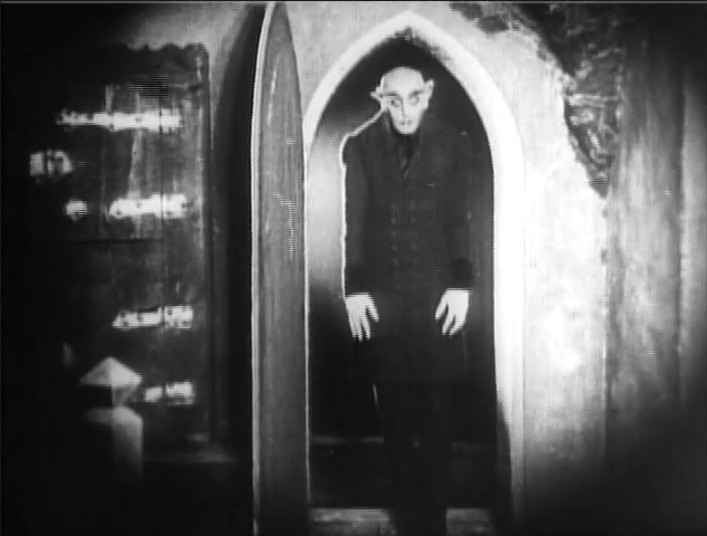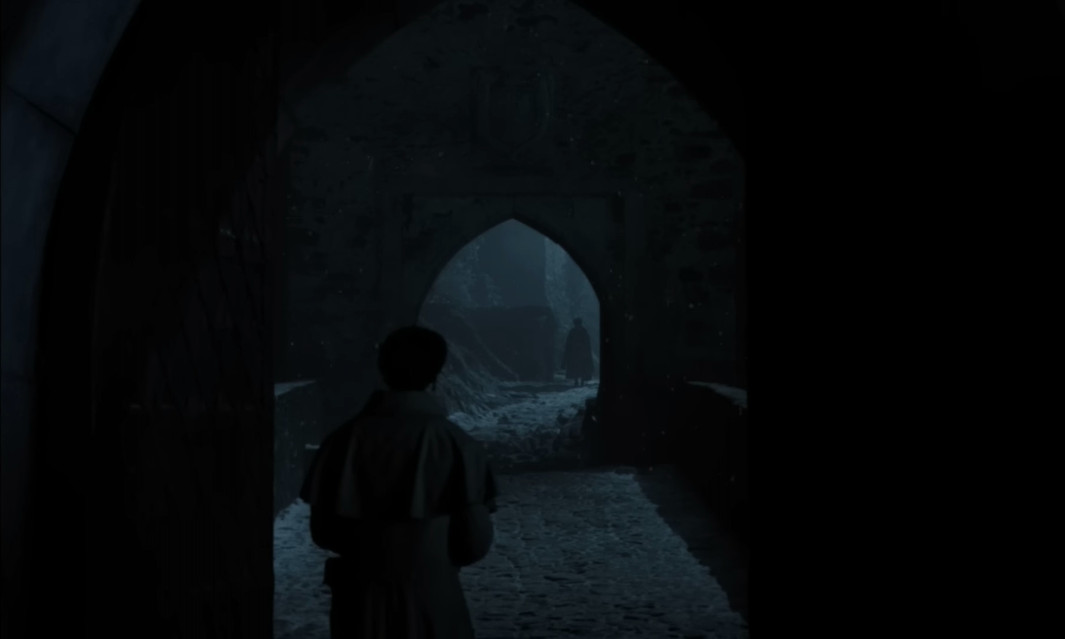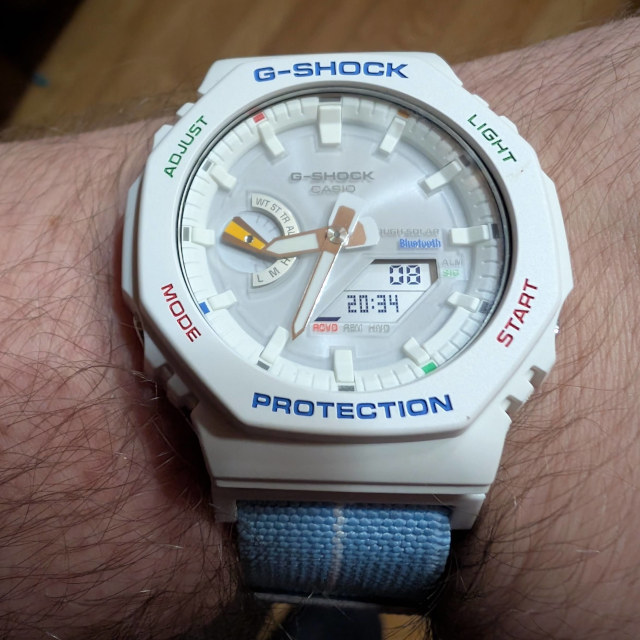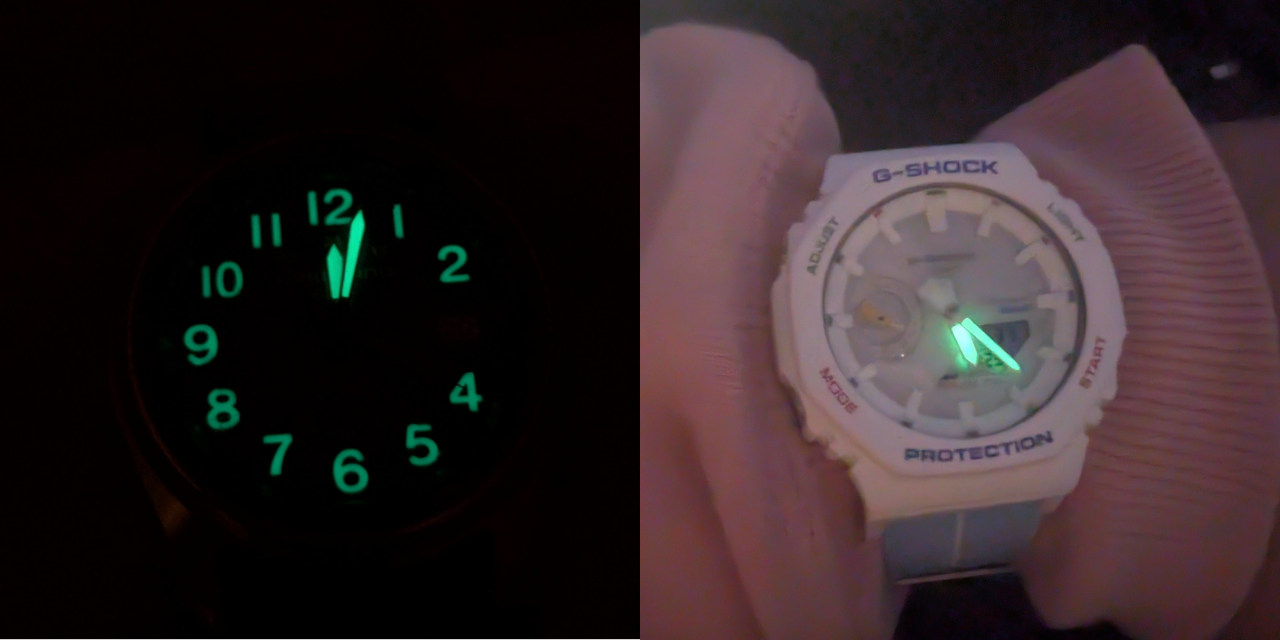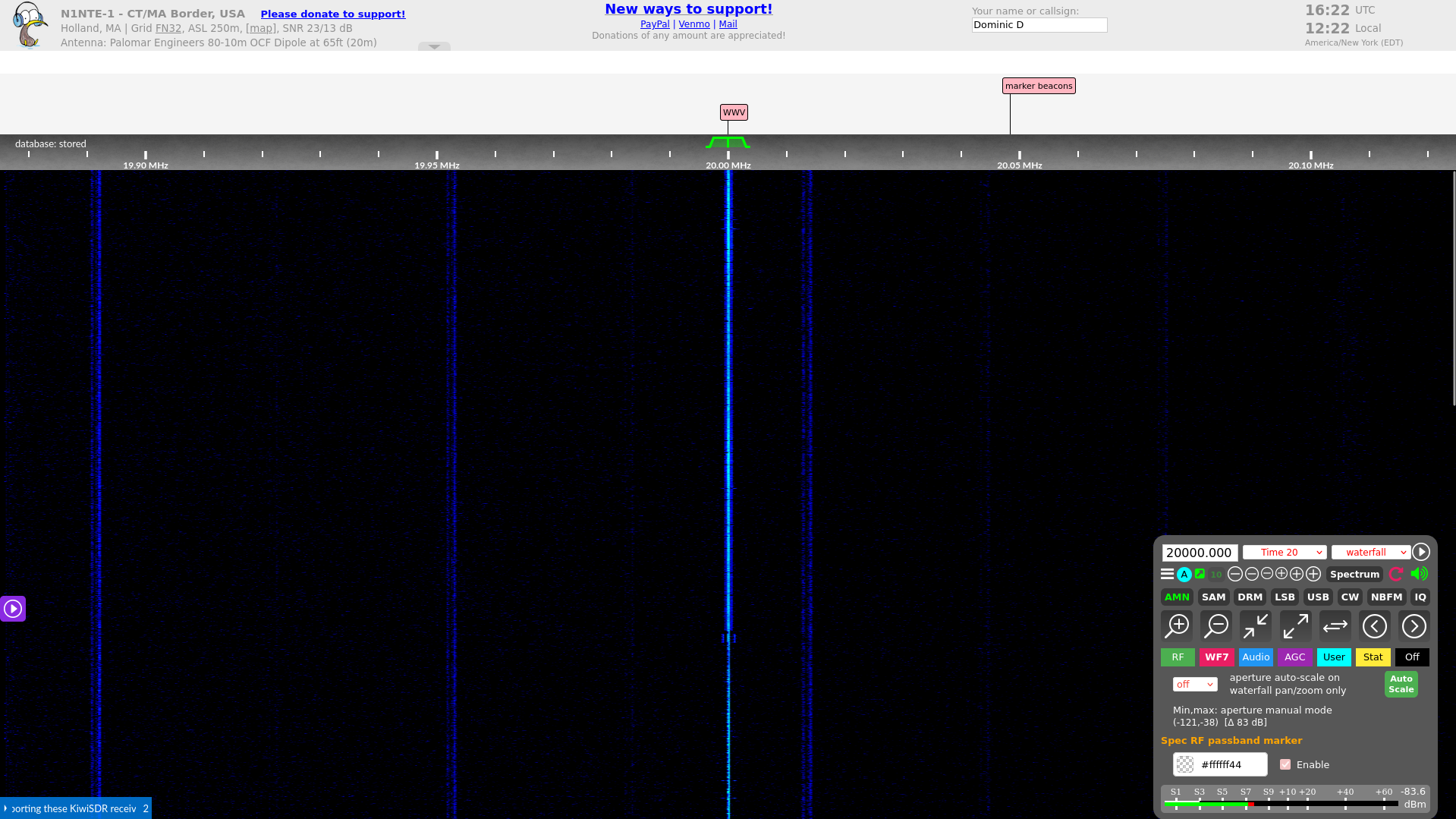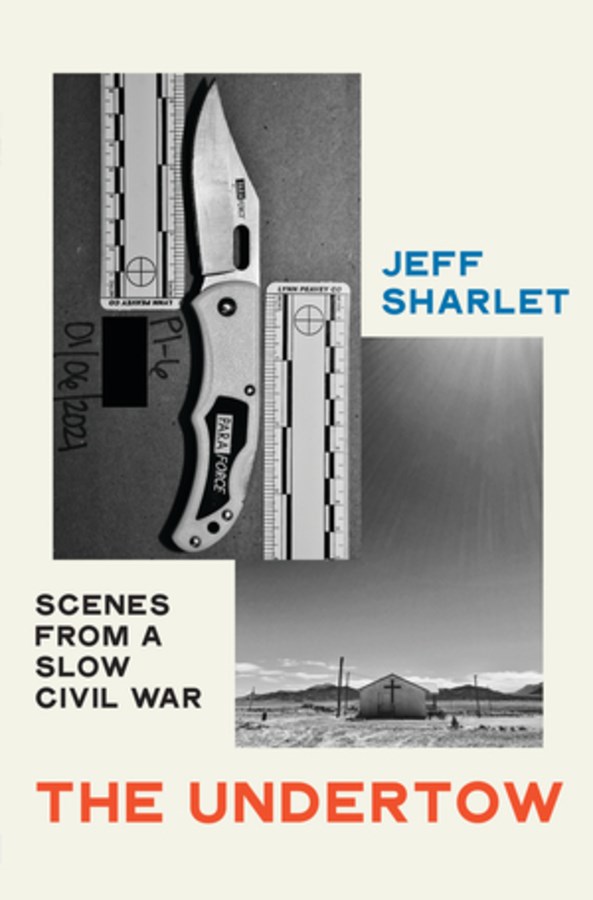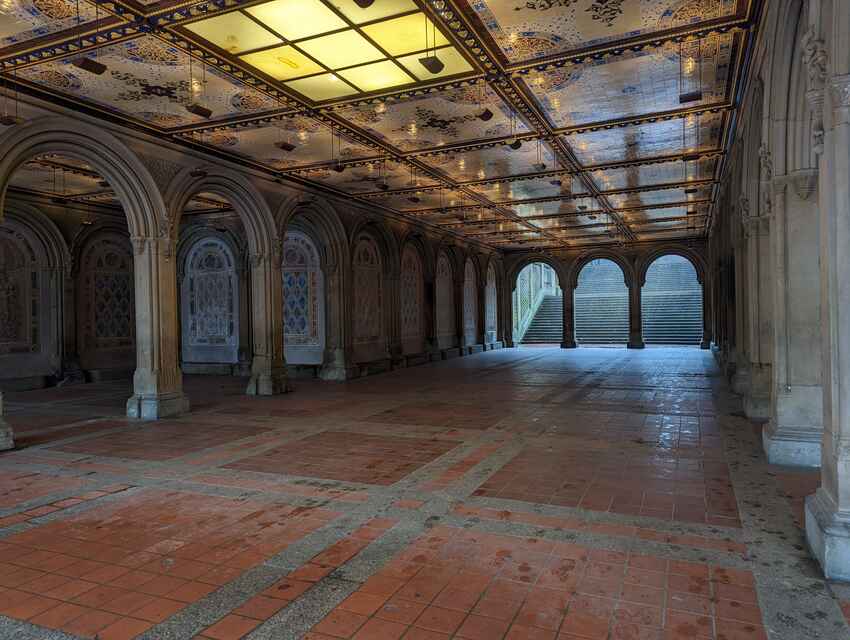When I was a high school student in Massachusetts there were certain people who liked to tell me I would really benefit from spending some time backpacking around Europe. It sounded nice, but those people never seemed to have any advice about how to raise money for the plane tickets, and none of the local stores would hire me at the time (shortly after the 2008 financial crash), so it never happened. But in June 2023 I delivered a talk at a technical conference in Brno, in the Czech Republic, so my first ever visit to Europe was paid for by my employer. I was there for a little over a week, and most of my waking hours were spent interacting with other conference-goers or with coworkers who were in town, but I managed to do some impromptu sightseeing anyhow and I got a lot out of the experience, even beyond the good it did for my work and professional relationships.
I've included a few photos, but I also have some more in a PixelFed collection for those who would like to see what some of these things look like.
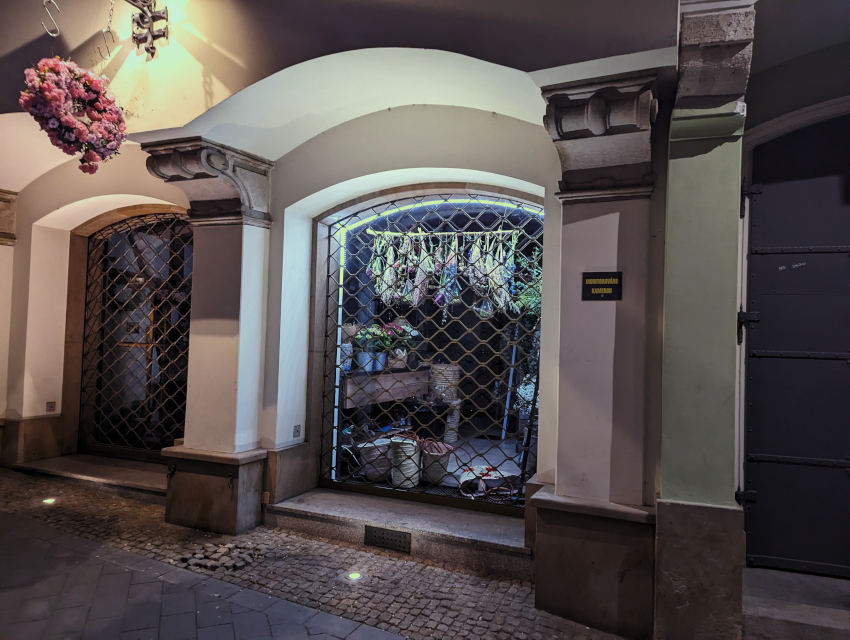
Flight
For someone who has flown relatively little in the past decade, who generally has to stick with economy class, and who has a fairly intense fear of heights, I actually really enjoy commercial air travel. I worry about the environmental impact of it all, and I don't like the gauntlet of security checks on the way into the airport, but I really enjoy watching arrivals from and departures to cities all over the world, navigating the strange architecture of airport terminals, the actual takeoff, and watching landscapes and cloudscapes pass by the window. For this occasion I used my employer's travel booking service to buy economy flights operated by United and Austrian Airlines, from Bradley International Airport (BDL) in Windsor Locks, Connecticut to Vienna Airport (VIE) in Austria, with layovers in Chicago O'Hare (ORD) during departure and Washington Dulles (IAD) on return. My employer used some unallocated travel funds to upgrade both of the domestic flights on my trip to United's Economy Plus class and buy me a United Club lounge pass for my Chicago layover.
I'd never personally been to any of the airports on this trip before, so everything was new from the moment I stepped onto the departures drop-off curb at Bradley. Bradley is not very big, an important regional airport but not a national hub, so the check-in process was relatively quick and easy to navigate compared to a bigger, busier airport like Boston Logan or Seattle-Tacoma. The domestic terminals at O'Hare were architecturally fascinating, the neon-lighted tunnels connecting them even more so, and using an airport lounge with a buffet and all was a new experience for me, a welcome opportunity to relax a little before shuffling over to the international terminal. That step was a little peculiar as it involved presenting my boarding pass and passport multiple times to board a shuttle bus that crossed various taxiways, stopping to allow planes to pass, on its way to the terminal building. My understanding is that this journey can be done more conveniently by train, but the train is located outside of the TSA-secured area.
The flight to Vienna was packed, as I could tell from the moment I saw the enormous crowd at the gate. The plane taxied across an overpass above an Interstate highway, something I'd never seen before. I had an arresting view of Lake Michigan during takeoff, but cloud cover was thick and I couldn't see anything outside from that moment until sunrise over Ireland. I didn't manage to sleep but I did watch Everything, Everywhere, All at Once for the first time and was very engaged in it.
As we descended over Lower Austria I saw endless fields of grain and countless wind turbines stretching toward the horizon.

VIE-BRQ
I had booked my train from Vienna to Brno in advance and had not left myself many hours to navigate to Vienna's main train station, so I proceeded through immigration and baggage claim as quickly as possible and took no time to look around the airport, instead following signs directly to the ticket kiosks for Austria's national railway ÖBB and using the company credit card to buy a ticket for a Vienna S-Bahn train to the main station.
The S-Bahn is a commuter rail network; I boarded from an underground platform below the airport without having to interact with anyone. The cars were sleek and modern with comfortable seats and convenient overhead racks that easily accommodated my carry-on-sized rolling suitcase. A small party of travelers that sat across the aisle included an Orthodox Christian priest; I tried not to stare because I recognized his traditional black garb from photographs but had never seen it in person. Only now, with nothing to do immediately except to sit and watch for my stop, did I begin to look around with idle curiosity instead of a single-minded navigational goal. The summer sun was intense that morning, and unhurried glimpses of the agricultural and suburban neighborhoods between the airport in Schwechat and central Vienna proper unfolded outside, punctuated by earthen banks covered in sun-bleached grass and concrete underpasses adorned in colorful graffiti. Eventually the buildings grew taller and clustered closer together, and soon enough we reached my stop, a big cluster of platforms where tracks converged from all directions under a big metal canopy, Wien Hauptbahnhof.
It turned out I didn't have to worry so much about arriving in time for the next train; I arrived before its platform was even announced. I might have had time to look around, but I was tired enough that I was beginning to budget my movements, conserving enough energy to at least get to the hotel, so I did little else than find a toilet and wait under the departures board until the train I had booked was listed there. Waiting for it on the platform I heard a lot of English from the other passengers. There were more people with U.S. accents than I expected, many of them young, maybe on their way to Prague to have a good time with their friends.
My train, when it arrived, had a somewhat antique appearance, but was still at least as comfortable as the S-Bahn. The seat I had booked had a little table I shared with one other passenger, and even in standard second class the ticket inspector gave me a small complimentary bottle of Rajec mineral water (a Slovak brand), which I very much needed. It didn't take long to leave the urban center of Vienna, and enter that seemingly endless landscape of wheat fields and wind turbines I'd seen from the plane, moving northward, near and parallel to the Slovakian border and bound for the Czech Republic. There was nothing to indicate we were approaching an international border, but I knew we had crossed into Czechia when we entered the town of Břeclav and stopped briefly at its rather sleepy platform. I wanted to fully absorb everything I could see through the windows, but by this point I was finding it a struggle to stay awake. Beyond Břeclav were even more wheat fields, and sometimes a small farm village on a hill, a little patch of red-tiled roofs around an old Catholic church tower. Our approach to Brno did not take us through its center, but there was a sharp increase in roads and small urban buildings as we neared the platform in Brno.
A magic kingdom
The Brno platform was not dissimilar to the one in Břeclav, but the train station into which it fed was a white nineteenth-century palace of transit, the ceiling of its main hall high and ornate. Out the door and across the street I started following the map on my phone to the Hotel International. Immediately I faced a steep cobblestone alley flanked by hundred-year-old buildings and overshadowed by the breathtaking Gothic towers of the Cathedral of Saints Peter and Paul. It's a scene that probably passes for normal in much of Europe, but to me it looked like something out of an over-the-top theme park.
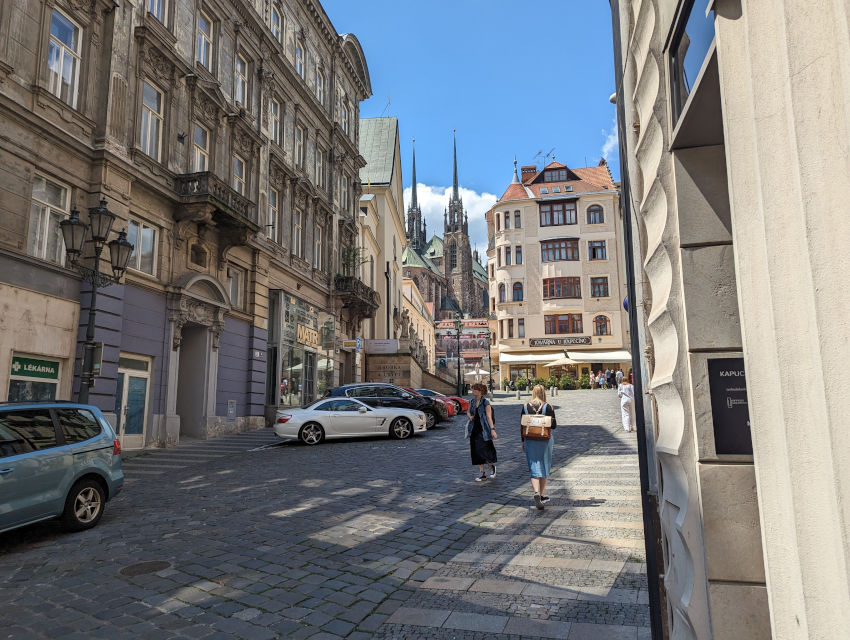
I was sweating buckets, and the wheels of my suitcase made a racket on the twisty maze of ancient streets until I reached the neat stone stairs of the rear entrance to the sprawling early-1960s functionalist hotel, beside its restaurant with patio seating. A glass elevator inside allowed me to forgo hauling my suitcase all the way up to the lobby. The receptionist behind the long black marble countertop helpfully answered my questions in English, but it turned out that I had arrived before check-in, so I found a small indoor shopping mall up the street with a Tesco Express, obtained some reserve cash in the form of Czech koruna banknotes from an ATM, and bought a soggy, plastic-wrapped caprese sandwich, and ate it slowly on a sidewalk bench outside.
On my phone, I followed up with coworkers who were also coming to town. R. from Spain had encountered a series of delays of his Ryanair flights and was beginning to doubt that he would arrive that day.
When I did ultimately check into my hotel room, the first order of business was to figure out how to turn on the bathroom lights—the switch was just outside the bathroom door, but it took time to work out that operating the lights throughout the room required leaving my key card upright in a little wall-mounted receptacle in the entryway. After that a shower was imperative, followed by a nap. I put on loose clothes, pulled the curtains over the large windows and glass door between the bed and balcony, set up my CPAP machine on a side-table, and easily fell asleep.
I awoke maybe an hour before dusk, refreshed and eager to have another look around. The balcony looked out onto an alley between the hotel and its parking garage—not a premium view, but a decent place to get some fresh air. At the balcony's outer edge, scaffolding ran up the whole face of the building; I was warned in Czech and English not to climb it by a temporary sign on the inner side of the balcony door. I wound up having most of my daily phone conversations with my family on that balcony, using WhatsApp video chat. Looking off the narrow sides of the balcony I could see some of the rooftops surrounding the old town's main square in one direction, and off the opposite side the edge of the park around Brno's Špilberk castle.
R. was still struggling with Ryanair, and M. had just wrapped up work in another part of town, so in search of a casual meal I would know how to order I changed back into sensible street clothes and walked out to find a bowl of poke in a little fast-food restaurant called Mr. Sushito, on a relatively modern street about five minutes from the hotel on foot. I ordered the “Mr. Salmon” bowl, and maybe should have just tried right away to piece together the right phrases in Czech, but instead asked, “Mluvíte anglicky?” It turned out one of the young women behind the counter knew English better than she seemed to think she did. I ordered the “Mr. Salmon” bowl, though the “Chicken Fuck Diet” bowl also sounded delicious. To my surprise, I was asked whether I wanted the samon raw or grilled. It did occur to me that I was enjoying poke in a place that was much further inland than home, but it didn't phase me enough that I would ask for cooked fish. And in the end it was everything I wanted, served in a ceramic bowl on a cafeteria tray with disposable chopsticks, a metal fork, and a little fish-shaped plastic phial of soy sauce, which I ended up pocketing and later finding amongst my things while unpacking at home because the food didn't really need it.
Going to school
I woke up early the next day—Friday—to plan out my day and catch the early end of the hotel breakfast buffet down in the restaurant: cold cuts, sliced cheese, various fresh-baked breads, fresh juices, espresso from a machine, compôte, honey, little jars of organic yogurt, and so on. I had a grand time savoring a selection of these on the patio, watching the unhurried comings and goings of people along the edge of the old town.
I had no word yet on whether R. had made it into town. M. from Brazil was already in Brno, but was heading to the conference in the opposite direction, from his hotel on the north end of Brno. So with my laptop in my backpack I set off to find the conference on my own. Not far from my hotel was the cobblestone main square, Náměstí Svobody, lined by restaurants and guarded by a handful of the city's most recognized landmarks: the ovoid black obelisk of the “astronomical clock,” the old fountain, and the Plague Column topped with a golden crown of sunbeams and adorned with the figures of saints associated with plague victims—it seemed not as quaint in 2023 as it may have in 2019. And not too far beyond this square was a green park crisscrossed by paved paths where people met and walked their dogs, and at the opposite It also sounded like at one point they werecorner of thar park I stepped onto a tram heading north and tapped my credit card at the fare-box.
The trams in Brno were frequent and clean, with clear recorded stop announcements and electronic signage displaying route details. Outside the windows as we left the town center, there were fewer Nineteenth Century buildings and more concrete structures reminiscent of the Warsaw Pact years, often topped with red tile roofs, painted in pastel tones, and lined with shops selling anything from döner kebab to puzzles and board games.
I found the university campus that was hosting the conference just around the corner from a tram stop, down a side street and past a mechanic's garage. It was a fairly large campus, not walled off from Brno but established long ago, and forming a large-enough cluster that I immediately got lost within it, looking for registration in vain. Eventually I got through to M. on my phone and found him on the campus, and we joined the queue forming outside the ornate oak doors to the old hall that held the registration desk.
M. was also giving a couple short talks at the conference, talks I found more interesting and dynamic than my own. He was more gregarious than I knew to expect, quick to ask all the most interesting questions of the people he met and also more than willing to describe his work experiences and his home in Brazil. I hadn't met any of my immediate coworkers or even my manager in person before; the last time I had met coworkers was in early 2020, before my university campus shut down due to the pandemic during my last semester, and since then I had converted from intern to full-time software engineer, been transferred to a team of people based in Spain, Czechia, and far-flung parts of the U.S., and officially become a remote employee.
The conference commenced, and throughout the weekend I attended sessions in every time slot that wasn't occupied with the impromptu meetings I ended up having in the shade of a chestnut tree in the courtyard with a gaggle of people I had known only through work videoconferences. I saw M's talk, and R's. My own was scheduled on a Sunday afternoon, nearly at the end of the conference, and given the timing I was impressed by how many people showed up. The university campus itself had lovely—centuries-old façades, thoroughly modern lecture halls within, and soft greenery all around.
In past years this conference was always held in the winter. Brno winters seem to be much like New England winters, judging from the numerous coathooks in lecture hall entrances. But in 2023 the first physical convening of the conference since the emergence of COVID-19 enjoyed balmy summer weather throughout, the skies overhead impossibly blue. Once, as several coworkers and I walked near the campus, M. noticed wheat growing wild from the cracks in the sidewalk. It would be unremarkable to any local, but it captivated me as something I'd never seen before. I guess I've just never lived in a wheat-growing region. For me it inspired a feeling reminiscent of that metaphor often used to describe what brought famine-stricken migrants to Ellis Island, that they had heard the streets of New York were paved with gold.
Ignis Brunensis
A conference social party was planned for Saturday night, and I had a ticket, but until Saturday its location was officially secret. It ended up happening at a public swimming pool and health club in a largely residential neighborhood not far from campus. The pool itself turned out to be off-limits for this event, but partygoers enjoyed a very well-catered poolside picnic and drinks. I heard a lot at the party—about different software companies where the attendees worked, about their various home countries and hometowns—as the sun took its sweet time in setting and the summer heat gradually eased.
I didn't stick around to the end of the party, as I was anxious to see that night's installment of Ignis Brunensis, an annual multi-week international fireworks competition. On that particular night the fireworks were to be preceded by a drone light show, something I'd never seen before. My coworker T. had grown up in Brno and was ready to relive his youthful days at the Brno Reservoir where the festivities were being held this time around. He called us a rideshare, so we'd make it in time for the lights, but we hopped out of the car on the side of the road, a short distance from the pedestrian crowd, to join them and spare the driver from being caught up in event traffic. I sensed a carnival atmosphere as we walked down the darkening leafy street—and in fact not far down the way we began to pass stalls plying food and beer, followed by glowing, whirling carnival rides. It all looked and sounded uncannily like any number of summer celebrations I'd seen in Massachusetts or Washington as a kid. One of the rides that looked a little too thrilling for my taste even sported a NASA logo (unlicensed, I'm sure). I guess some things are the same the world over. T. graciously offered to buy me a beer; I'd have struggled to string together the right phrases in the dark and noise of the scene. So we joined the people gathering around a boat launch just beyond the rides and stalls to crane their necks and see whatever spectacle was about to transpire over the water, and I sipped a golden, intensely hoppy beer that smelled like freshly mulched garden weeds. It had been so long since I'd experienced this specific vibe of just existing within a crowd engaged in the simplest kinds of pleasures. I'd forgotten this kind of experience was possible. A brief and passionate quarrel broke out, which ended in a young woman berating her companion in a way that seemed to momentarily embarrass everyone in earshot. Even with the cursory Czech study I'd done before the trip, I couldn't make out a word; T. said they were speaking Ukrainian. But it all seemed to resolve in harsh words and a parting of ways, and the mood quickly mellowed again. Some young people confidently climbed a tall structure I saw mainly in silhouette, that looked like the prow of a ship, to get a better view.
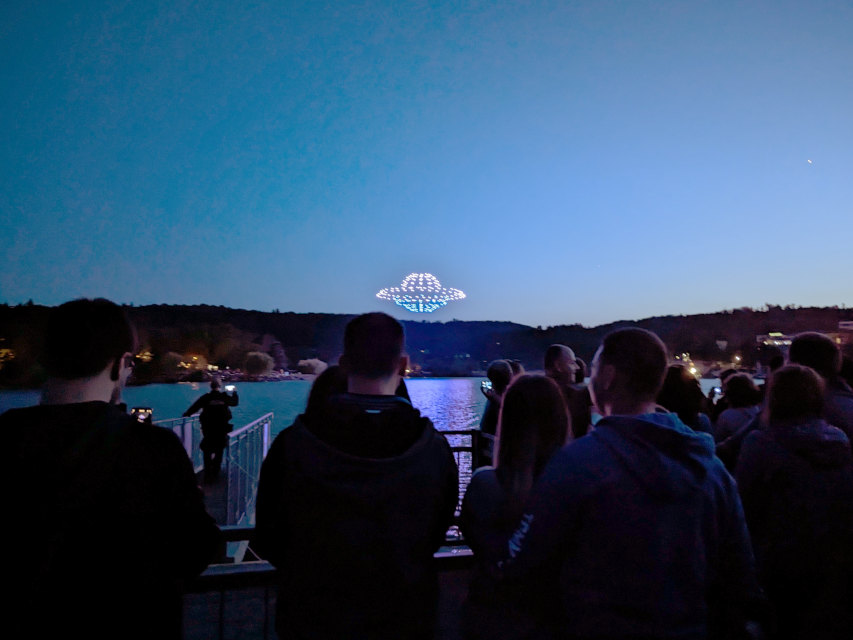
As soon as the sunlight was fully gone, lights appeared over the water, seeming to slowly signal to each other and align in a kind of calibration procedure before flickering out, only to reappear in the shape of a rotating flying saucer. A Czech radio announcer voice, accompanied by the X-Files theme, announced the drone light show and began to wax poetic about the mysteries of the universe; T. summarized it for me as a speech about how “we don't know shit” about the natural world. Meanwhile the flying saucer dissolved and the drones rearranged themselves in a succession of rotating, three-dimensional shapes: an obelisk, a pyramid, Neptune's trident, a double helix. And then, soon after the drones, the fireworks. We watched Sweden's entry; I would return another night to view Norway's from the top of a dam. The display was synchronized played over music played over a speaker at the boat launch and on a local FM radio station, not that I could hear it over the explosions that night. I'm no connoisseur, but the colors, the shapes, the timing were all mesmerizing. What stuck with me, though, was just that feeling of watching it with the crowd, a feeling that brought me back to a time before the pandemic that started three years before.
War stories
During the conference I joined my manager and M. for lunch at a nearby bistro, and M. asked my manager a question I would have been too timid ask: “What was it actually like to live in Communist Czechoslovakia?” My manager's response was measured and ambivalent. Sure, he said, career options were limited. There were some restrictions on what one could say in public and study at university. But materially? By the 1980s, people basically had what they needed. In that respect things weren't so bad.
Ivan, a coworker from another department, shared a different geopolitical perspective over dinner at a restaurant downtown one evening. Ivan had grown up in Montenegro and was a child during the wars of the 1990s. He recalled times when he heard things, times when no one would go into town even for groceries. He recalled that during some of the worst times NATO forces came by with food aid, including some strange kind of cheese he'd never seen elsewhere—probably “government cheese,” I suggested. M. said the bloody history of Brazil could be summarized as the ruthless suppression of a succession of various regional and indigenous independence movements. R. was disquieted by the crackdown that had followed the Catalan independence referendum of 2017; he quipped that “Democracy is illegal in my country.”
Everyone was very nice to me while I was in town, but in the corporate office vibes were off. Some months prior the company had announced an unexpected round of layoffs in North America amid objectively rosy market performance figures, and just after the conference the corresponding European layoffs were announced following regulatory clearance.
About town
Outside the conference, working hours, and scheduled social events, R. turned out to share my interest in exploring the town, so he and I improvised a few self-directed walking tours of downtown Brno. We saw cathedrals—at least from the outside, as we hadn't chosen times when these were actually open to the public. We explored the town's main squares. Once, during a lunch break, my manager indulged my quest to find a paternoster elevator in a university campus building near the office; it turned out to be closed off due to construction (as was another paternoster elevator in the old post office building), but he later led R. and I around the terraces of Špilberk, full of provocative public art installations and architectural quirks, and at this point the only castle I've visited in Europe. Seeking even more spectacular views of town, R. and I visited the Old Town Hall (stará radnice) one evening at dusk, paid a small fee to climb its tower, and proceeded with an exhausting ascent of the many staircases leading to the top, where we were rewarded with magnificent panoramic views of Brno. The narrow walkway around the tower was guarded by a railing about waist high or even a bit higher; this did not fully assuage my fear of heights but I lingered up there much longer than I otherwise might have just because of the colors, the sounds of music from the streets below, the visibility extending over rooftops all the way to the hills outside town.
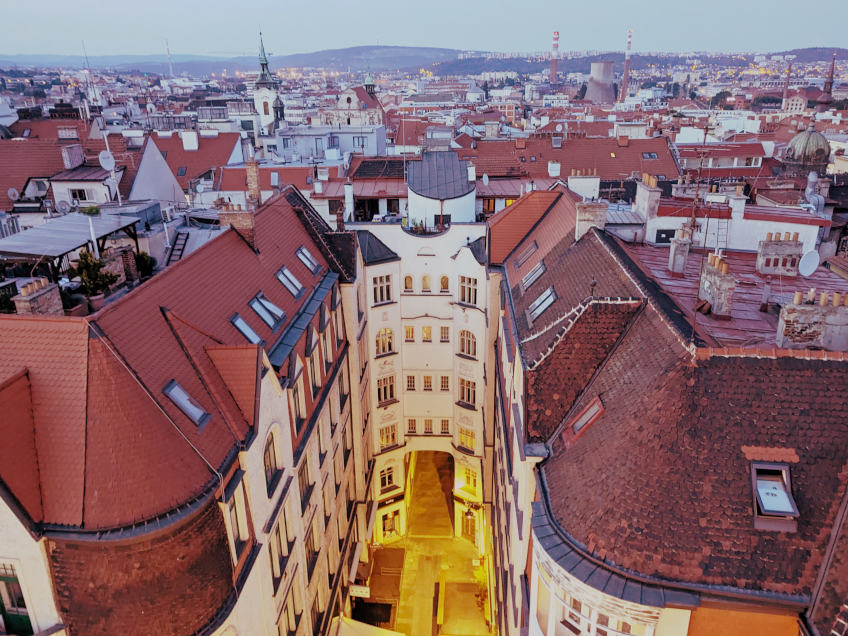
On another occasion R. and I visited Brno's unique 10-Z Bunker museum, near our hotel and under Špilberk. 10-Z has a wild history; it served as a bomb shelter during the Nazi occupation, briefly became a wine store after the war, and was later seized by the Czechoslovak army who turned it into a self-sufficient fortified bunker for nuclear emergencies, complete with air filtration systems and a telephone exchange. Today the museum showcases the features of the bunker itself but also displays objects and ephemera of the Cold War period in Brno, from public signage of the period to antique telephones, magazines, and portraits. I even saw the cover of a vinyl album of a reading of Leonid Brezhnev's memoir Целина (Virgin Lands, in Russian), and thumbed through copies of an old Czech-language child development journal Děti a my (Children and Us). 10-Z even offers bed-and-breakfast-style lodging for tourists who want to experience staying the night in a Cold War bunker, and I might have done this if I were less busy. Before leaving the museum we passed through a kitchen / dining area presumably used to feed overnight guests, with lovely mismatched antique plates and teacups, a worn old upright piano, vintage stereo equipment and so on. There was a rack of assorted vinyl records offered as complementary souvenirs; I picked up an LP pop compilation featuring Czech-language covers of various international hits.
I eventually even found a paternoster elevator. One morning I arranged to start my day at the office a little later so I could look around town a bit on my own, and I found a municipal government building allegedly containing one of these contraptions I'd never seen in person. Sure enough there it was, in all its wood-paneled glory, constantly whirring and turning. Concerned that I would have to explain to someone why I was taking a joy ride on the elevator in their office, I only rode up one floor and then back to ground level. But it was a smooth ride, and finally I had fulfilled a goal I held since I first saw the opening of The Prisoner with Patrick McGoohan.
I ate a lot of good food in Brno. My favorite restaurant of those I tried was Stopkova Plzeňská Pivnice, a sort of microbrewery with dark green interior walls. I felt compelled to try svíčková na smetaně, the Czech national dish, and I quite liked it, but my favorite single dish was the restaurant's Pilsner goulash (plzeňský guláš) which, of course, I ate with a glass of Pilsner Urquell (which every Czech-speaking person who ate with me seemed to simply call Plzeň—also the Czech name for the city in which the beer is brewed). But I also have to give mention to smažený sýr—fried, breaded cheese traditionally served with potatoes and tartar sauce. It's like something a person would create specifically to lure me onto a transatlantic flight.
Letní kino
For my last evening in Brno I booked a ticket to watch Asteroid City (in the original English, with Czech subtitles) at an outdoor cinema event. It was just me this time; I'm a simpleton who likes Wes Anderson's movies and I don't often get around to watching any kind of movie at home with the kids at home. The showing was scheduled in an area on the east side of Brno called Nová Zbrojovka, a disused industrial park that was being gradually redeveloped as a mixed-use residential/commercial neighborhood. I walked down to Brno's main train station, got one last good look at the place, and caught a tram to a stop called Náměstí Republiky, where I stepped onto a side street and immediately entered a quiet residential neighborhood of tightly-packed single family houses. At the end of the street was a few light-industrial buildings and a small bridge across a canal. I crossed there, turned a corner, and walked right into a party.
There was a park at Nová Zbrojovka, and it was filling with young families who had gathered for some kind of neighborhood barbecue. A live band performed from a small pavilion. Behind the park I could see where a cinema screen was set up against the wall of a factory—a stately old building shaped much like the ideal of a factory, like a factory emoji, but definitely disused. Over the sceen large white letters on the indigo factory wall advertised Letní kino. But I was early, so I tried to be inconspicuous at the back of the park, soaking in the music and atmosphere while I talked to family back home on my phone. The band's set seemed almost calibrated to make me homesick: “Wish You Were Here”, “California Dreamin'”. I can't recall for certain, but they may have even played “Homeward Bound”. On the phone, my partners asked if I missed America yet. The truth was that as much as I missed my family, our kids, the cat, I hadn't been gone long enough to start missing America in the slightest.
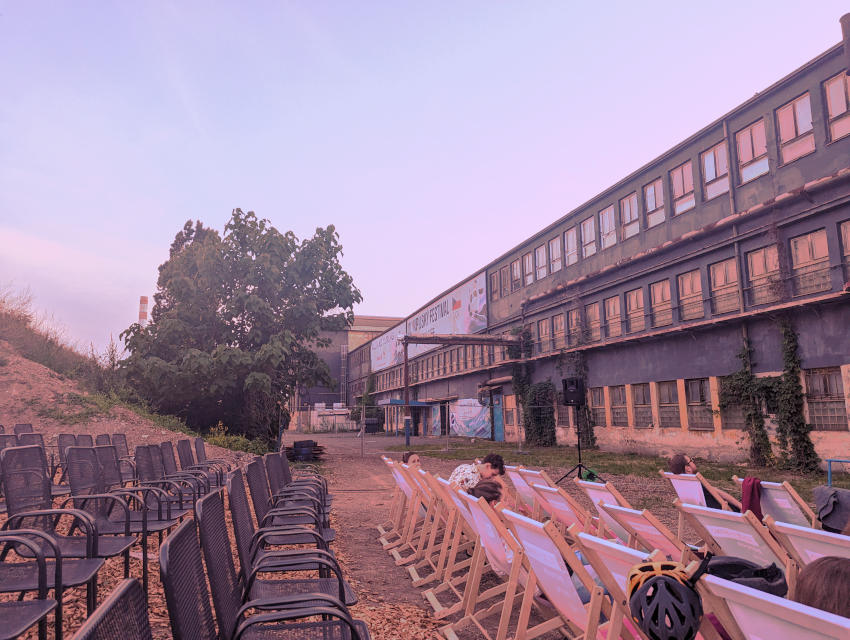
Beside the gate in the fence around the little yard where folding chairs were arrayed in front of the screen, there was a yellow shipping container converted into a snack stand for the cinema. I bought onion rings, which turned out to be more of a Funyuns-like dry packaged snack than the greasy, deep-fried onion rings one finds at a clam shack back in New England. And to wash it down I bought a tall can of non-alcoholic beer, a grapefruit radler. The movie was attended well enough. I spotted a couple of people who sounded very much like they must be U.S. expats, but I didn't try to make conversation with anyone. The slow sunset cast everything in crazy pastel hues.
Much like the Ignis Brunensis drone light show, the movie was of course scheduled to begin as soon as the sunlight had fully faded. The audience was appreciative, laughing audibly right from the opening sight gags involving a train rocketing through a desert somewhere near the Nevada-California line. Some of the audience were audibly surprised by the scene in which Jason Schwartzman's theater actor character and Edward Norton's playwright character in the movie's metanarrative abruptly transition from a discussion of craft into sexual foreplay, but I felt like I could see that development building within the scene and it seemed an appropriate nod to the widely known but often censored or repressed sexuality of historical figures like Tennessee Williams and his contemporaries. Asteroid City turned out to be the perfect movie to end my trip. It was at once the funniest and the most troubling Wes Anderson movie I had seen. In some ways it's a kind of free-associational response to the pandemic; a major part of the plot involves a group of people reacting against and subverting a quarantine imposed upon them for somewhat understandable reasons, and, like a virus, the alien visitor that animates the story is neither a benefactor nor consciously an enemy to humanity, but instead unknowable and unsettlingly indifferent to the human world. Rather than resolve the crisis of meaning that emerges from this senseless intervention in the lives of its characters, the movie ruptures the boundary been text and metatext when a metatextual acting exercise stumbles upon the statement “You can't wake up if you don't fall asleep.” This refrain is at once a meaningless tautology and a gesture toward the struggle of the characters to impose meaning onto a chaotic world without relying on foolish dreams, fantasies, and stories. At first its repetition by the actors in the exercise reads as a joke, but then it goes on for an uncomfortably long time, and soon the movie ends with everyone—all the actors, all the players in the metanarrative, all the characters in the main narrative, staring straight into the camera and chanting, “You can't wake up if you don't fall asleep.” It's hard to explain how terrifying this is after the gradual breakdown of the movie's narrative structure; it's a little like Persona in that way. The effect was also enhanced by watching the movie with an emotive group of people and outdoors; the audience reactions became part of the story, and I even remember one moment when characters in the movie looked to the sky just as a commercial jet passed overhead in real life.
Navigating back to the hotel after the movie turned out to be a little trickier than expected, because it hadn't occurred to me that I would be leaving after the trams shut down for the night. I started out walking at a respectful distance behind two young men in football shirts who were also on their way out of the movie and headed in the same direction. They seemed just a little intoxicated, like maybe they were drunk on the strange stillness and warmth of that summer night more than on actual beer. At one point they threw their arms around each other and began to raucously sing “Bella ciao”. It seemed like they were planning to catch the next bus down the road, but I was worried it would be crowded, so I turned onto a side street and started to navigate to the hotel on foot. But I soon realized it was a foolish distance to walk at that hour, and near-total silence of the unlit apartment buildings around me, the sudden awareness that I could see no one else on the streets I was walking, made me think better of it. So I found my way to a bus stop where a bunch of people, most of them seemingly twenty-somethings, were gathered in waiting. Outside our little crowd there were few signs of life apart from the blue glow from a window in the apartment building accross the street where some insomniac was watching TV.
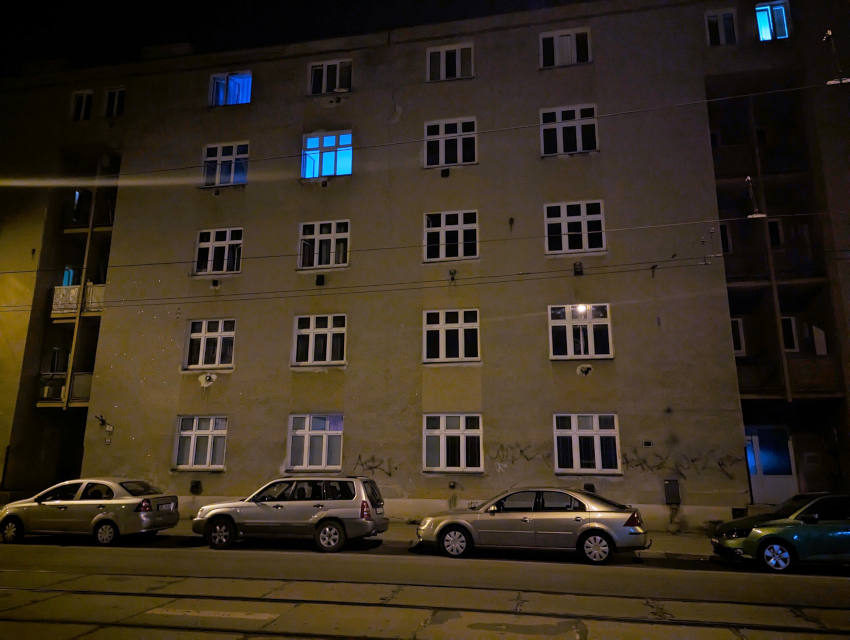
When the bus finally arrived it was very crowded, but I was happy to ride it all the same. I disembarked on the other side of the town center from the hotel, and walked the rest of the way, stopping briefly to peer into an antique tram that had been parked in the central square for late-night sightseers. I slept very well for a few short hours before I awoke to catch my flight.
There's not much interesting to say about getting back home. I turned down some very good advice to spend a night in Vienna before my flight, and so in order to arrive at the airport a few hours early as I prefer to do, I had to book an intercity bus instead of a train. This turned out to be a bad idea, as the bus arrived hours late and Brno's bus station was not nearly as well cared for as the train station, though I will say that when the bus finally arrived it was the most comfortable bus I'd ever sat in, and in the end I did make it onto my flight. I did all my passport control and customs screening during my connection at Dulles International, riding one of their unusual mobile lounges in the process.
In all, I was in Brno for eight days. It must have been a long time for my partners at home, and for our kids. For me, with everything new I saw in that time, it seemed to go by in the blink of an eye.
Where not otherwise noted, the content of this blog is written by Dominique Cyprès and licensed under a Creative Commons Attribution-ShareAlike 4.0 International License.


